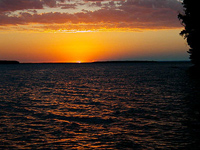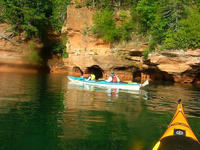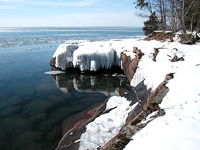
also in recreational:
about
advertise
subscribe
contact
site
map
The Apostle Islands
Escape to Wisconsin's Superior sanctuary
Sublimity replaces solitude as you watch the glowing embers of sunrise pull Lake Superior out of a frosted night sky. The golden spectacle splashes bands of orange and pink across the ice-encrusted lake as shadows of birch trees dance along the snowy shoreline. Then you notice something. The glittering Big Dipper of the northern sky is superseded by a new constellation as a cluster of silhouettes emerges from this backdrop.
Sitting quietly in the largest of the Great Lakes, 22 islands compose the Apostle Islands archipelago, a patchwork of sandstone sanctuaries just off the Bayfield Peninsula in northwestern Wisconsin. Home to sea caves, old growth forests, beautiful beaches and abundant wildlife, these islands are 600 million years of geology at work.
While this collection of gems received its name from early Jesuits, its transcendence now draws a new breed of disciples—outdoor enthusiasts seeking to escape the pandemonium of city sidewalks for the stillness of nature. In winter, these are the few who exchange their loafers for snowshoes, tramping quietly among the islands’ snow-laden wooded trails and sparkling ice caves. Yet as the area transforms into the “Caribbean of the North,” these same visitors paddle sea kayaks from island to island in pursuit of tranquil bays. Whether by sea kayak or snowshoes, serenity awaits year-round as the islands whisper, “Welcome.”
The cloud nine of Wisconsin winters
While islands and winter are not generally synonymous, especially in the cold waters of Superior, snowshoeing in the frosted landscape of the Apostle Islands challenges all of that. Snowshoers can make their escape on Madeline Island, home of Big Bay State Park, where nearly 2,400 acres of woodlands await exploration. Situated on the edge of a snow belt, the island welcomes about 79 inches of powder each year—making ideal conditions for this sort of off-road hiking.
“When you get out in really deep snow, you get to see why somebody wears snowshoes and what effect they have, and that makes it fun,” says Mark Eggleson, park superintendent at Big Bay State Park. “There are marshy areas of the park that are difficult to get to most of the year, but in the wintertime you can snowshoe back in those areas and see beaver dams and lodges, whitetail deer, eagles flying overhead, otter
tracks … you name it.”
The wooded island offers remoteness unrivaled by other snowshoeing destinations. Here, you can get away from the bustle of city noises, heeding to nothing but the sound of your own tracks and the cracking of branches as heaving snow falls off of a red oak’s limbs.
“It’s just like a leisurely walk in the woods,” says Larry McDonald, owner of Apostle Islands Outfitters (AIO) in Bayfield. “But if you want to treat it like you’re climbing Mount Everest, it can be a lot harder too … then again, most of us don’t want to do that.”
Judging from the laughter in McDonald’s voice, snowshoeing needn’t be an Everest expedition. Big Bay State Park offers 2.6 miles of groomed snowshoe trails for those who aren’t quite ready for winter backcountry travel. Snowshoeing dates back 6,000 years and offers a simplicity that caters to beginners.
|
||||
 |
||||
| open waters: Splashes of orange and pink race across Superior toward Oak Island as the sun sets. photo courtesy mark eggleson |
||||
slide show: your virtual island tour get a glimpse of the area's breathtaking views |
||||
 |
||||
| paddle, paddle: Kayakers paddle curiously toward shorelines heaping with sea caves. photo courtesy hoofer outing club |
||||
 |
||||
| winter wonderland: Visitors to a wintery Big Bay State Park can enjoy stunning displays of iridescent icicles as they drip from red sandstone. photo courtesy mark eggleson |
||||
related article: Taking time to breathe |
home
| professional
| recreational
| practical
| social
about | advertise
| subscribe
| contact
| site
map
curb magazine 2005: balance for wisconsin's young professionals
